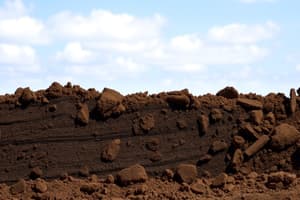Podcast
Questions and Answers
What does USCS stand for?
What does USCS stand for?
- Universal Soil Classification System
- Unified Soil Classification System (correct)
- United Soil Classification System
- Unified Soil Consistency System
What are fines in soil classification?
What are fines in soil classification?
Soil particles that pass through a #200 sieve called silt or clay.
Name the mineral types in soil classification.
Name the mineral types in soil classification.
Gravel, sand, clay, and silt.
What is bearing capacity in soil?
What is bearing capacity in soil?
What is the composition of soil?
What is the composition of soil?
Which of these describes poorly-graded soil types?
Which of these describes poorly-graded soil types?
What characterizes uniformly graded soil?
What characterizes uniformly graded soil?
Describe gap-graded soil.
Describe gap-graded soil.
Clean soil contains less than 5% fines.
Clean soil contains less than 5% fines.
Dirty soil contains more than 12% fines.
Dirty soil contains more than 12% fines.
What does plasticity refer to in soil classification?
What does plasticity refer to in soil classification?
Match the soil types with their abbreviations:
Match the soil types with their abbreviations:
What does Soil Gradation - W indicate?
What does Soil Gradation - W indicate?
What does Soil Gradation - P indicate?
What does Soil Gradation - P indicate?
What does Soil Plasticity - H indicate?
What does Soil Plasticity - H indicate?
What does Soil Plasticity - L indicate?
What does Soil Plasticity - L indicate?
What is coarse-grained soil also known as?
What is coarse-grained soil also known as?
Flashcards are hidden until you start studying
Study Notes
USCS Soil Classification Overview
- Unified Soil Classification System (USCS) is a standardized method for classifying soils based on their physical and engineering properties.
- Soils are composed of a mixture of minerals (45%), air (25%), water (25%), and organic material (5%).
Soil Components and Types
- Fines refer to soil particles that pass through a #200 sieve, categorized as silt or clay.
- Mineral types in soil include gravel, sand, clay, and silt.
- Soil can be classified as either coarse-grained (granular) or fine-grained, which influences its engineering properties.
Soil Gradation
- Poorly-graded soils can be categorized into uniformly graded and gap-graded types:
- Uniformly graded soil has particles of nearly the same size.
- Gap-graded soil features a mix of large and small particles, with missing intermediate sizes in the gradation.
- Gradation affects how well soil can support loads and its drainage characteristics.
Clean vs. Dirty Soil
- Clean soil is defined as having less than 5% fines, making it suitable for specific engineering applications.
- Dirty soil has more than 12% fines, which may include silty or clayey materials and can affect load-bearing capacity.
Soil Plasticity
- Plasticity describes the behavior of fine-grained soils as their water content changes.
- High plasticity indicates that a soil retains shape and form easily, while low plasticity signifies more brittle behavior.
Soil Classifications by Type
- Soil types are designated by letters in the USCS:
- G: Gravel
- S: Sand
- M: Silt
- C: Clay
- O: Organic
- P: Peat
Soil Gradation Classification
- Soil gradation is further classified as:
- W: Well Graded
- P: Poorly Graded
Plasticity Index
- Plasticity is assessed on a scale of High Plasticity (H) to Low Plasticity (L), affecting the soil's usability in construction and other applications.
Studying That Suits You
Use AI to generate personalized quizzes and flashcards to suit your learning preferences.


